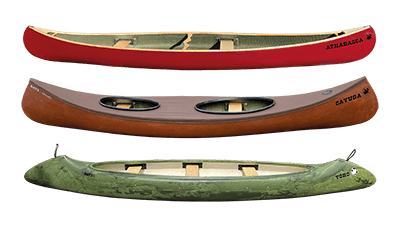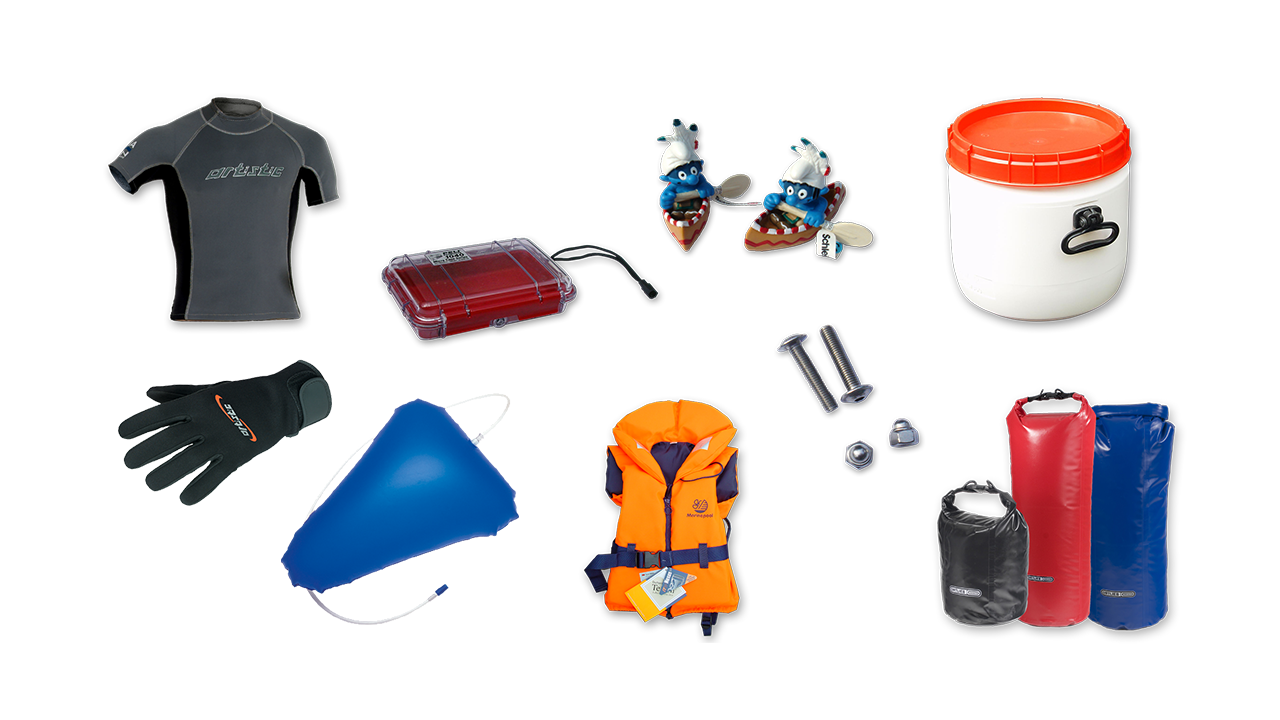FAQ
Frequently asked and important questions and the answers about your Gatz canoe
According to the definition, canoe is the generic term for watercraft moved forward in the direction of view with paddles or muscle power. A distinction is then made between Canadians, which are propelled forward with paddles and originate from the indigenous peoples of North America, and kayaks, which are propelled with double paddles and originate from the Inuit. In common usage, however, the canoe is often equated with the Canadier.
The choice of which type of boat is right for you depends primarily on personal circumstances. One-person kayaks, especially the models equipped with steering systems, seem to be easier to manoeuvre than a one-person canoe, especially for beginners, although with the stand-up paddle and the easy-to-learn technique, one-person canoes can also be moved with ease. Two-man canoes, and of course the larger models, are steered by the stern paddler using the paddle. The occupants can also paddle unsynchronously or put the paddle aside. Unlike the double paddle, the stand-up paddle shaft does not drip water into the boat and the paddlers sitting further forward do not get splashed. The paddling technique is easy to learn, the basic strokes (see driving technique in the service section) will lead you to your goal in no time. Many paddlers also use different types of boats for different areas of use. The beauty of canoeing is that you can always be on the move in the different boat categories.
Every boat exposed on the water is also exposed to the wind when it blows, the sailor is happy about it, -the paddler is disturbed by the wind in some situations. The area of use must also be taken into account here, because on small rivers the influence of the wind (depending on the meandering, also from changing directions) is much smaller than on a large lake. Decisive for the effect of wind on canoes is, apart from the wind direction and strength, the total wind-attack area of the boat above the waterline and to what extent draught and hull shapes can have a compensating effect here. The bow shapes of the vast majority of Canadians can be neglected here, because the same area that projects more into the wind in traditional bow shapes has flatter bow shapes at the front, even with greater leverage applied.The relevant area is often less than 1/2 sheet of paper in size. The height of the paddlers or wide jackets have more of an influence if you assume that you are choosing a boat that is suitable in size, i.e. not oversized. Another decisive factor is the shape of the hull (information in the service section), i.e. how the canoe lies in the water. A lot can also be achieved in windy conditions with the right trim. In addition, coaming shapes such as those found on most canoes made by Gatz-Kanus and, above all, a functioning tarpaulin are helpful.Because this takes away a complete surface of attack (the inboard wall) from the wind coming in diagonally from above, it considerably reduces the surface of wind attack. Few paddlers go out in strong winds and storms anyway. Weather and wind forecasts are helpful tools and available on every smartphone.
In the past, keels were used in wooden boats as reinforcement or protection.Canadiers made of modern materials, as they have been processed by GATZ-Kanus for decades, do not need a keel as protection or reinforcement. Gatz-Kanus has never manufactured canoes with outer keels. Keels, which are often found as reinforcement in cheap boats or in aluminium canoes because they are riveted there, are susceptible to grounding and reduce manoeuvrability. For the less experienced canoeist, reduced manoeuvrability also means that it is more difficult to get the boat back on course. The bottom stiffness in our canoes is designed in such a way that a certain flexibility remains, but otherwise bottom contacts are usually distributed over the entire surface, or rarely hit the same area again and again.
The composite material group, which also includes GRP (glass-fibre reinforced plastic), is still very important in the canoe market (as long as we are talking about canoes with a high quality of material and workmanship). Especially the quality canoe in high-quality composite construction (with aramid-carbon reinforcements or in lightweight construction) is becoming more and more popular. However, the quality of the canoe is crucially dependent on the materials used in its manufacture (fibres and resin components), their technical processing and the manufacturer's expertise in shaping. High-quality raw materials and technically correct processing, i.e. exactly what Gatz canoes have stood for for over 60 years now, result in long-lasting boats. Here we are proud to see that certainly the majority of all canoes and kayaks ever built by us are or can still be used today. Equally important is the right material construction. Cheap boats made of pure GRP, often in the heavy boats resulting spray laminate and usually manufactured in low-wage countries, are sometimes offered at prices for which a manufacturer in the high-quality sector cannot even buy the raw materials. The result usually speaks for itself after a short time.When you look at the cheap boat on offer, you simply have to do some backwards calculations (VAT out, freight subsidy out, dealer margin out, transport to the dealer out, manufacturer's earnings out) and then you are left with a frighteningly low amount, which must be enough for both the wages and the material used.... Quality has its price, which is always justified by decades of life expectancy and high resale revenues. The variants of the Gatz composite material group, as well as the PE and, until a few years ago, Royalex materials used by us, allow Gatz-Kanus as a manufacturer to produce an optimal, durable and stable-value product for you in every area.
How you ride best is entirely up to you. In the Canadier you can bend your legs, stretch them, let them dangle overboard, ... There are seats with and without backrests. You, or even children, can lie down in the boat or sit on a flat seat on the boat floor. The healthiest position for the spine is kneeling. With a straight back, the muscles are strengthened. Knee mats that also support foot flexion are very comfortable. Most of the body weight rests on the inclinable and removable (important for comfort and safety!) seat board. All seat positions can be changed quickly, even af tour, thus avoiding one-sided strain. When kneeling, you have much more contact with the canoe (knees, feet and buttocks) and the centre of gravity of the boat is lower than in a sitting position. The result is more safety and riding pleasure. Try out the variants in your canoe, it is very pleasant when you are not fixed to one sitting position for hours like in other types of boats.
No, because even a large family canoe, which weighs around 39kg in standard construction (in carbon, for example, the same boat weighs only 29kg), is usually carried or loaded by at least two people, and that leaves a maximum of just over 19kg per person, which is considerably less than most touring or white-water single kayaks, which also have to be moved alone. In carbon, 2-person canoes, like the Canoki, are available from 18kg. If you then use a few leverage laws for weight distribution when loading (the stronger or larger partner simply grips the canoe more in the middle of the boat) and commercially available, practical loading aids, handling even the largest boats becomes a simple exercise with little practice. Land transport is also child's play with a suitable boat trolley. Questions? When you collect your canoe from us, we will show you how easy it is to load.
That is answered quite quickly: We build your canoe "Made in Germany"! In other words, every Gatz canoe and kayak is handcrafted for you in our factory, which is actually more of a manufactory, in Cologne. From the boat design, model making, mould making, - right up to the finished boat with many unique equipment details -, every canoe is made for you, partly in elaborate manual work, by our specialists. Even the production machines, such as our large vacuum thermoforming plant for the Royalex production, are planned here in Cologne with reference to the respective material and, as far as possible, manufactured ourselves. This ensures optimal production conditions for durable quality boats "Made in Cologne, Germany". We have been proud of this seal for over 60 years! No Gatz canoe comes from countries with wage dumping or Eastern European / Asian cheap production. We are also your contact for repairs. Very few, if any, importers offer you this.
Anyone who contacts our team at Gatz-Kanus has already decided that a boat with handling characteristics/performance and quality is on the shortlist. We are pleased about this trust. First you determine what you actually want to do with the canoe. Even if you only plan a few trips a year, a boat that may seem more expensive at first glance will pay off. The resale value is higher, the life expectancy considerably longer and a boat that is fun to use because it runs well and is also easier to move on land is used more often. Take advantage of the filter options on the website and the buying guide on the website with its carefully compiled information. You will also find more advice on materials and boat shapes there. In addition, the experts at Gatz-Kanus will also be happy to help you in person, by phone or by e-mail. We process all the important materials and know their properties; we paddle our canoes ourselves. We love and live canoeing. For you, this always means optimal and objective first-hand advice. Importers have to sell what the foreign manufacturer delivers to them and sometimes also what may have been in stock for a long time, Gatz-Kanus as a German manufacturer produces the boats that are needed by our customers themselves. In addition to our expertise, you can also take advantage of our test drive offer. Only this opportunity for comparison can bring your own personal boat feeling into the purchase decision. Tests in magazines and forums cannot do this because, unfortunately, they can never be objective except for the presentation of technical data. Unfortunately, we also experience that in the media, buying advice is given by people without any practical relevance. We deliberately mention the possibility of a test drive when several models are being considered. In our eyes, it would be wrong to advise you on one type of boat, as is unfortunately often the case in some "specialist shops", just because it is currently in the shop. From the positive feedback of our satisfied customers, we know about the positive benefit of a test drive, even if you have to travel a long way, when deciding which boat will be your companion for many years. If the test is not possible, we are still convinced that a good consultation will lead you to the best canoe for you.
Often our customers only want to remove visually disturbing scratches. Now and then, it can also be a very deep scratch caused, for example, by a piece of iron or sharp-edged stones in the riverbed, or even a small break that should be repaired in the interest of a long life expectancy. All 3 material groups in which GATZ canoes are or were produced can be repaired. Tips on this and other care instructions can be found in the SERVICE section of this website as download files (PDF) divided into material groups. The materials for composite and Royalex repairs can also be found in the SHOP on this website. PE canoes can only be permanently repaired by welding. We also carry out all repairs for you in our factory by appointment. Before you repair "wrong", please ask us. Often 1-2 pictures by mail are enough to point you in the right direction.
In the 1980s, serial numbers began to be attached to one of the rear seat supports (these are made of black PP/Pocan from 1981). The first two numbers or sometimes only the first number usually gives information about the production period +/- 6 - 8 months .PE and Royalex canoes have the number on a rear seat support or on the coaming, as do wooden rimmed canoes. Royalex canoes sometimes also had an impact number on the inside stern area. Other features include: GRP seat pads (pre-1981), persennin strip with flat cove (pre-1986), old or new moose logo and models or model cycles that are no longer in production.
We oil the wooden edges several times all around with oils for outdoor use (e.g. Bondex UV oil natural, available in DIY stores and online) before delivery. However, you can normally use any commercially available colourless oil for outdoor use. In any case, we recommend a test on a small area to check whether the oils are compatible. In the north, the Owatrol oil, which is also very popular in Scandinavia, is often used. Most teak oils, e.g. from yachting accessories, also work, but are often coloured. Varnished wood edges can be treated with 2-component varnishes or boat varnishes. Here, too, it is always important to test a small area to see if the varnishes are compatible. Before varnishing, the old varnish must be sanded or even completely removed and the wood must be dry.
This is only right if you are only interested in a unique experience with an all-round care package. Of course, you have to load up your own canoe and take it to the water. On the other hand, you have to make an appointment with the rental company and invest time in the handing out of the equipment and instruction. The routes are usually predetermined. You do not necessarily need 2 vehicles or other paddling partners if you are travelling individually. At many waters you can get back to the starting point by train, you can also deposit a bicycle at the destination or put a folding bike in the boat. There are often other paddlers who can help move the car and even a taxi has a manageable cost for most routes of day trips. With your own canoe, you have maximum flexibility, even a quick after-work trip is possible, and you can also leave a lot of money with the rental company if you go more often. Usually more than the loss in value of your own boat if you use it much more often.
There is certainly a trend in society towards less ownership, but with your own canoe, as described in the previous answer, the advantages are obvious. With my own canoe I can get to waters where there is no landlord and I always have sensible boat equipment with me on holiday. I can paddle when the rental company is closed, e.g. also in the cold but beautiful season and in spring. As soon as a longer holiday tour with a canoe is planned, the rental boat quickly costs more than the loss in value of my own boat over several years. Irrespective of the fact that any damage caused must usually be paid for privately (unlike in the case of a car). Gatz canoes are so durable that even if the hobby stops for a while, the material can still be used by you or the next generation.
Undoubtedly yes, and many solo canoeists have been able to get to safety in storms or other adverse conditions on large waters with a shareable double paddle carried along. In some situations, the double paddle and the higher stroke frequency can achieve the goal faster. In the two-man canoe, you rarely see the double paddle, because here the stern paddler can steer and the bow paddler provides propulsion. For some, the double paddle in the canoe is a visual break in style, but paddle manufacturers such as Bending Branches have extra-long double paddles for use in the canoe in their range with the Impression Solo and the Slice Solo. For paddlers who like to use both paddle variants, we have developed the Gatz-CANYAK model Beothuk after our INUIT, which also allows different seating arrangements.





